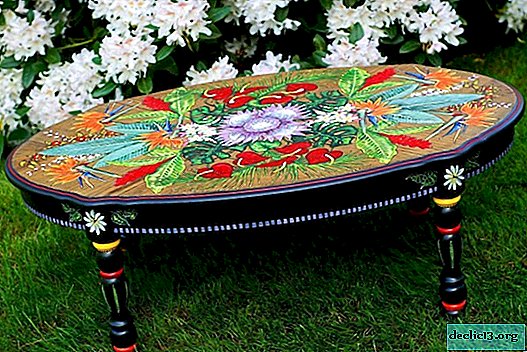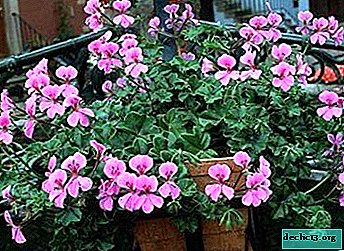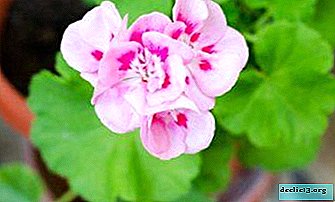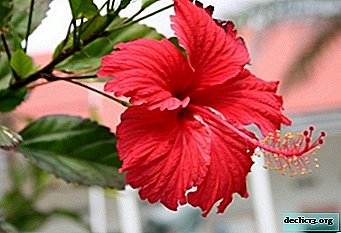Recommendations for gardeners to care for geraniums in open ground
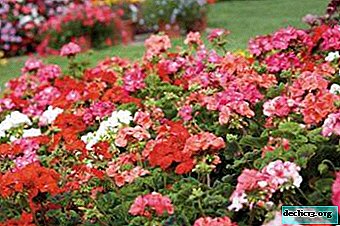
Geranium is a perennial, rarely annual plant of the geranium family, including up to 400 species of perennials and about 200 annuals (pelargonium). Wild geranium is found in all regions of Russia, where the climate is temperate.
All types of garden geraniums are characterized by the fact that they are unpretentious, like their natural ancestors, tolerate severe winters and summer droughts. They are also more decorative, having a diverse bright color of large flowers and beautiful leaves.
Features of growth on the street
On the street you can grow both annual geranium, which is more correctly called pelargonium, and perennial, the most popular among gardeners.
Pelargonium loves heat, so it is usually planted on the street only in the summer months, and then brought into the heat. In the garden, sunny areas are more suitable for her, but partial shade will not hinder blooming all summer. Some varieties of pelargonium for a garden plot:
- ampelous (for flowerpots) Ville de Paris and Lachskonigin with flowers of pink-salmon color;
- Holstein with pink inflorescences;
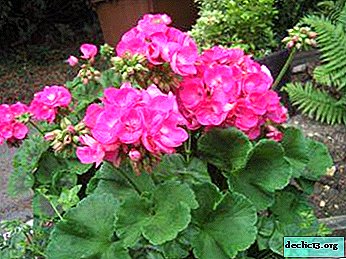 Carnaval with double flowers of crimson with white splashes;
Carnaval with double flowers of crimson with white splashes;- Le Pirat with dark cherry double flowers;
- Sybil Holmes with large double flowers of pink color on the outside and almost white inside;
- zonal (Zonal pelargoniums) - planted in the summer in the garden using container planting;
- thyroid or ivy (Pelargonium peltatum) with creeping shoots;
- Enzett Richards Schrader - terry flowers are distinguished by salmon-pink color;
- Suprema - purple flowers in the shape of small roses;
- Shimmer - large flowers of a coral shade.
A big plus of garden plantings of geraniums is that weeds grow poorly next to it because of the released essential oils.
How to plant?
Before planting geraniums, you must:
- determine the time of landing;
- choose a suitable place on the site;
- prepare the material (seeds, seedlings or rhizomes);
- equip landing pits.
Watch a video about planting geraniums in open ground:
Time
Garden geraniums are planted in early spring and early autumn. In the spring, you can start landing in the first half of May, when the earth warms up to + 15-18 ° C. After planting, if necessary, the plants are covered.
Seat selection
Soil composition is a general requirement for planting all types of geraniums, as she does not like clay and loamy soils (about what kind of soil loves indoor geraniums and whether universal soil is suitable, read here). The land must be fertile and necessarily without stagnant groundwater in order to avoid root decay.
Advice! If the soil is clayey, add peat or rotted compost to it.With the variety of varieties of geraniums, it is not difficult to choose the right kind for almost any garden site. For example:
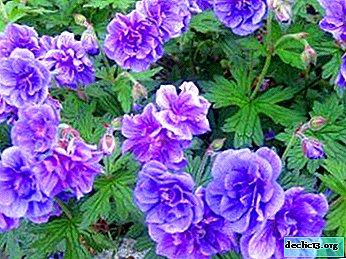 if the sun will suit a lot: meadow (G.pratense), Himalayan large-flowered (G.himalayense = G.grandiflorum), red-brown (G.phaeum) or magnificent (G.x magnificum);
if the sun will suit a lot: meadow (G.pratense), Himalayan large-flowered (G.himalayense = G.grandiflorum), red-brown (G.phaeum) or magnificent (G.x magnificum);- on a shaded place - large-rhizome or otherwise Bulgarian, Balkan (G.macrorrhizum);
- where wet soil is marsh (G. palustre);
- for an alpine hill - Georgian geranium (G.ibericum);
- for flower beds and flower beds - species with higher plants, above 50 cm: red-brown (G.phaeum), meadow (G.pratense);
- for planting along the tracks - low, up to 50 cm: large-rhizome or otherwise Bulgarian, Balkan (G.macrorrhizum).
Material
Can be used:
- seeds;
- rhizome;
- seedlings.
The best option would be to purchase seedlings with a closed root system. They are characterized by good survival in the ground.
Landing pits
Adult geraniums have long roots with lateral shoots, and therefore it is important to take this feature into account when making spacious pits.
Requirements:
- the pit should not be shallow (about 20 cm deeper than the length of the roots of the seedling);
- a layer of small stones, broken brick or gravel should be poured to the bottom - this is drainage;
- for drainage - a layer of a mixture of peat, sand, rotted compost.
After landing, be sure to:
- water the plant abundantly;
- mulching the soil - sprinkle with dry peat, compost or bark.
About how, when and why to plant geraniums at home, we talked about here.
How to care for a plant in the summer in the garden?
Gardeners appreciate geraniums not only for their decorativeness, but also for their simple care. It requires minimal effort and includes:
- watering;
- top dressing;
- pruning.
Read about how to care for room geranium at home and in the garden here, and from this article you will learn about the rules for caring for home geraniums in winter.
Watering
 Watering is needed regular, but moderate, you can not fill the plants, otherwise root rot will appear. Here you need a middle ground, because drought is also undesirable: geranium will stop flowering altogether or the flowers will become smaller and the leaves will wither (foliage can recover after watering). The ideal option is when the next watering is done only after the soil has dried out.
Watering is needed regular, but moderate, you can not fill the plants, otherwise root rot will appear. Here you need a middle ground, because drought is also undesirable: geranium will stop flowering altogether or the flowers will become smaller and the leaves will wither (foliage can recover after watering). The ideal option is when the next watering is done only after the soil has dried out.
Excessive watering is also able to provoke a cessation of flowering.
Top dressing
 Geranium does not need plentiful feeding, usually there is enough compost and peat brought before landing in the pit. Excess fertilizer will negatively affect the formation of flowers, but you can help the plant in moderation to bloom.
Geranium does not need plentiful feeding, usually there is enough compost and peat brought before landing in the pit. Excess fertilizer will negatively affect the formation of flowers, but you can help the plant in moderation to bloom.
Even before flowering, use phosphorus fertilizers to fertilize geraniums. The use of potash fertilizers (once every two weeks) during the formation of inflorescences and even with their active flowering will provide large lush inflorescences.
Read more about when and what is better to feed geraniums for lush flowering, read here, and from this material you will learn how to properly use iodine with hydrogen peroxide to feed the plant.
Pruning
Why pruning is necessary:
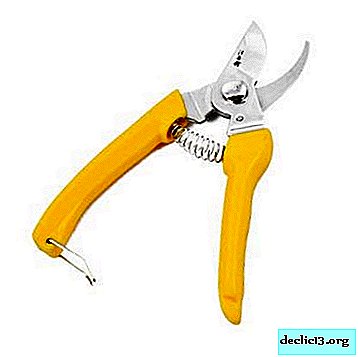 cut geraniums in order to form a bush, which gives it a compact and decorative look;
cut geraniums in order to form a bush, which gives it a compact and decorative look;- pruning also has a prophylactic purpose to protect young shoots and leaves, as dried flowers and leaves are attractive for gray rot (Botrytis cinerea Pers fungus).
Read more about how to pinch geranium correctly so that it is healthy and beautifully blooms, read here, and from this article you will learn about why the plant needs to be cut and how to do it correctly.
Possible problems and illnesses
Important! If the color of the leaves changes, the trunks dry out, blackening is observed near the root, then it is obvious that the plant suffers from pests or disease (powdery mildew, gray rot, spotting).Signs of the disease:
- yellowing and dryness of leaves due to irrigation;
- bare stems (usually from below) with a lack of light in photophilous species;
- stains and rot when infected with fungi.
Pest Control:
- if aphid - it is recommended to use a spoon of ash extract when watering (it is prepared as follows: 1 spoon of wood ash is infused in 1 liter of water);
- whitefly and various ticks - biological insecticides are used for destruction;
- caterpillars are assembled by hand.
Insecticide treatment alone is not enough and spraying must be repeated after 5-7 days.
How to transplant?
 Geranium feels good in one place for even ten years, but because prone to strong growth, it is transplanted every two years by islands located from each other at a distance of 20-30 cm.
Geranium feels good in one place for even ten years, but because prone to strong growth, it is transplanted every two years by islands located from each other at a distance of 20-30 cm.
A transplant is best done in the spring (how to transplant geranium at home can be found here). The landing pit should be deep enough so that the branched root system is located freely. After being placed in a pit, the plant must be watered and the soil must be mulched to avoid drying out.
Outdoor breeding
Geranium propagation is possible:
- seeds;
- seedlings;
- rhizome division;
- cuttings;
- self seeding.
Self-seeding is when the ripened geraniums spontaneously open and the seeds fly around around the neighborhood. In spring, seedlings can be found far from the main plantings of the plant.
Thus, self-seeding allows you to update the appearance of the garden plot, but on the other hand, the gardener gets the wrong garden design that he was counting on. That is why, to exclude self-seeding, unripe fruits must be removed.
Attention! If you want to propagate the planting of geraniums, you can easily get new plants by applying the division of an adult bush in early autumn. For propagation, any part of the plant is enough to plant in the ground, water and cover with a film.Both annual pelargonium and perennial garden geraniums are colorful bright garden decorations throughout the summer. At the same time, all representatives of the geranium family are not only decorative, but also unpretentious, without requiring complicated care.

 Carnaval with double flowers of crimson with white splashes;
Carnaval with double flowers of crimson with white splashes; if the sun will suit a lot: meadow (G.pratense), Himalayan large-flowered (G.himalayense = G.grandiflorum), red-brown (G.phaeum) or magnificent (G.x magnificum);
if the sun will suit a lot: meadow (G.pratense), Himalayan large-flowered (G.himalayense = G.grandiflorum), red-brown (G.phaeum) or magnificent (G.x magnificum); cut geraniums in order to form a bush, which gives it a compact and decorative look;
cut geraniums in order to form a bush, which gives it a compact and decorative look;
